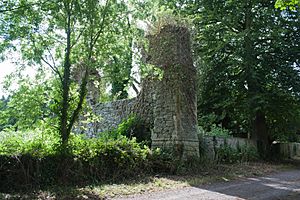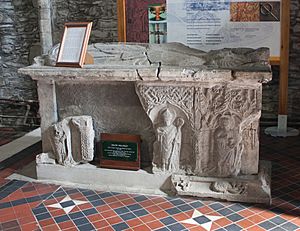Great Connell Priory facts for kids
Great Connell Priory (which is Prióireacht Chonnail Mhór in Irish) was once a special religious house. It was home to a group of monks called Augustinian canons. These monks followed the rules of Saint Augustine. The priory was dedicated to Saint Mary and Saint David. You can find its remains on the east side of the River Liffey, near Newbridge in County Kildare, Republic of Ireland.
The Priory's Beginning
Great Connell Priory was started in the year 1202. It was founded by Meiler fitz Henry, who was the grandson of King Henry II. Meiler fitz Henry also helped start other religious houses in Ireland. This priory was connected to another priory called Llanthony Priory in Wales.
The priory was built just north of a place where people could cross the River Liffey. This crossing was known as Connell Ford. The priory was given a lot of land in the areas around it. In 1203, a king named Faeláin Mac Faeláin became a monk there and later died at the priory. Meiler fitz Henry, the founder, also joined the priory in 1216 and passed away there in 1220.
At one time, there was a rule that only English monks could join the priory. However, it seems this rule was not always followed strictly. Later, when the priory was in danger of closing, the leader of the monks said that no Irish monks had ever been allowed in.
Growing in Importance
Great Connell Priory became one of the most important monasteries in an area called the Pale. The Pale was a part of Ireland that was controlled by the English. The priory gained a lot of valuable property over time.
In 1455, the King gave the priory permission to buy even more land. At its most powerful, it was thought to own a huge amount of land – about 1260 acres! It also owned 6 churches, 5 castles, and a mill. The leader of the priory was also a member of the Irish Privy Council. This was a group of important advisors to the King in Ireland.
An Important Leader
The most influential leader of Great Connell Priory was Walter Wellesley. He became the prior (leader of the monks) before 1520. He was so important that he even became the Bishop of Kildare in 1529, but he remained the prior of Great Connell at the same time.
Walter Wellesley had a lot of influence with King Henry VIII. When the King decided to close many religious houses, Walter Wellesley tried very hard to save Great Connell Priory. For a short time, he was successful. However, he died in 1539. After his death, the priory no longer had such a strong protector.
The Priory's End
Great Connell Priory was eventually closed around 1540. The last prior, Robert Wellesley, agreed to its closure. The priory's property was then given to different people over the years. First, it went to Edward Randolfe, then to Sir Nicholas White in 1560, and finally to Sir Edmond Butler in 1566.
Much of the stone from the original priory was taken away. It was used to help build the British Cavalry Barracks in Newbridge in the early 1800s. Around that time, parts of Walter Wellesley's tomb and other old pieces were found. They were built into the wall of the cemetery at the priory site. Walter Wellesley's tomb was later moved in 1971 to Kildare Cathedral. It was put back together by the County Kildare Archaeological Society with help from Gerald Wellesley, 7th Duke of Wellington.



